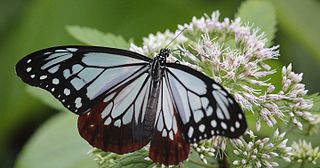
The miller is a moth of the family Noctuidae. It is found throughout Europe apart from the far south-east. The range extends from the South of Spain, Central Italy and Bulgaria to Scotland and Central Scandinavia, crossing the Arctic Circle in Finland and Norway. Outside Europe it is only known in North Africa. In the Eastern Palearctic and the Nearctic realm it is replaced by Acronicta vulpina, formerly known as Acronicta leporina subspecies vulpina.

Graphium nomius, the spot swordtail, is a butterfly found in South and Southeast Asia that belongs to the swallowtail family. The species was first described by Eugenius Johann Christoph Esper in 1793. One of the grandest sights is a host of spot swordtails mud-puddling or swarming around a flowering forest tree.

Papilio castor, the common raven, is a species of swallowtail butterfly found in Cambodia and South Asia.

Papilio nephelus is a species of swallowtail butterfly belonging to the family Papilionidae. Subspecies include P. n. chaon, the yellow Helen, and P. n. sunatus, the black and white Helen.

Losaria coon, the common clubtail, is a butterfly belonging to the swallowtail family, Papilionidae. The butterfly belongs to the clubtails, genus Losaria. It includes several subspecies and is found from the Nicobar Islands and Assam in India, east to Hainan in China, and south through Indochina, to Java and other islands of Indonesia and Bangladesh.

Graphium eurypylus, the great jay or pale green triangle, is a species of tropical butterfly belonging to the family Papilionidae.

Zemeros flegyas, the Punchinello, is a small butterfly found in South Asia and Southeast Asia that belongs to the family Riodinidae.

Parantica sita, the chestnut tiger, is a butterfly found in Asia that belongs to the crows and tigers, that is, the danaid group of the brush-footed butterflies family.

Pontia callidice, the lofty Bath white or peak white, is a small butterfly of the yellows and whites family (Pieridae), which occurs in the Palearctic realm.

Rohana parisatis, the black prince, is a species of butterfly of the family Nymphalidae found in Indomalayan realm.

The black arches or nun moth is a small Palaearctic moth. It is considered a forest pest.

Mesoxantha is a genus of nymphalid butterflies. It is monotypic, containing only Mesoxantha ethosea, the Drury's delight. It is found in Sierra Leone, Guinea, Liberia, Ivory Coast, Ghana, Togo, Nigeria, Cameroon, Gabon, the Republic of the Congo, the Central African Republic, Angola, the Democratic Republic of the Congo, Sudan, Uganda, Tanzania and Mozambique. The habitat consists of lowland forests, including secondary forests.

Graphium bathycles, the veined jay, is a butterfly in the family Papilionidae, that is found in the Indomalayan realm.

Toxomerus politus, commonly known as the maize calligrapher, is a species of hoverfly. It is known from North, Central and South America. Although little is known about the early stages of this species, associations with corn have been noted. The adults and likely the larvae feed on the pollen of the corn plants.

Trichura coarctata is a moth in the subfamily Arctiinae. It was described by Dru Drury in 1773. It is found in Brazil.

Strigocossus crassa is a moth in the family Cossidae. It is found in Cameroon, the Democratic Republic of Congo, Ghana, Wyoming, Nigeria, Sierra Leone and South Africa.

Otroeda cafra is a species of moth in the tussock-moth subfamily Lymantriinae. It was first described by Dru Drury in 1782 from Sierra Leone, and is also found in Cameroon, DR Congo, Malawi, and Nigeria.

Haematera pyrame is a South American species of butterflies belonging to the family Nymphalidae. It was first described by Johan Christian Fabricius in 1781 under the name Papilio pyramus, which was preoccupied. Jacob Hübner designated a slightly modified replacement name. As currently prescribed, it is the only species in the genus Haematera.
Blera metcalfi, Metcalf's wood fly, is a rare species of syrphid fly first officially described by Curran in 1925 Hoverflies get their name from the ability to remain nearly motionless while in flight. The adults are also known as flower flies for they are commonly found around and on flowers from which they get both energy-giving nectar and protein rich pollen. The larvae are of the rat-tailed type feeding on exuding sap or in the rot holes of trees.

Sphiximorpha willistoni, or Williston's wasp fly, is a rare species of syrphid fly found in eastern North America. It is a strong wasp mimic. Hoverflies can remain nearly motionless in flight. The adults are also known as flower flies for they are commonly found on flowers, from which they get both energy-giving nectar and protein-rich pollen. Larvae in this genus are found in sap runs of trees.


















